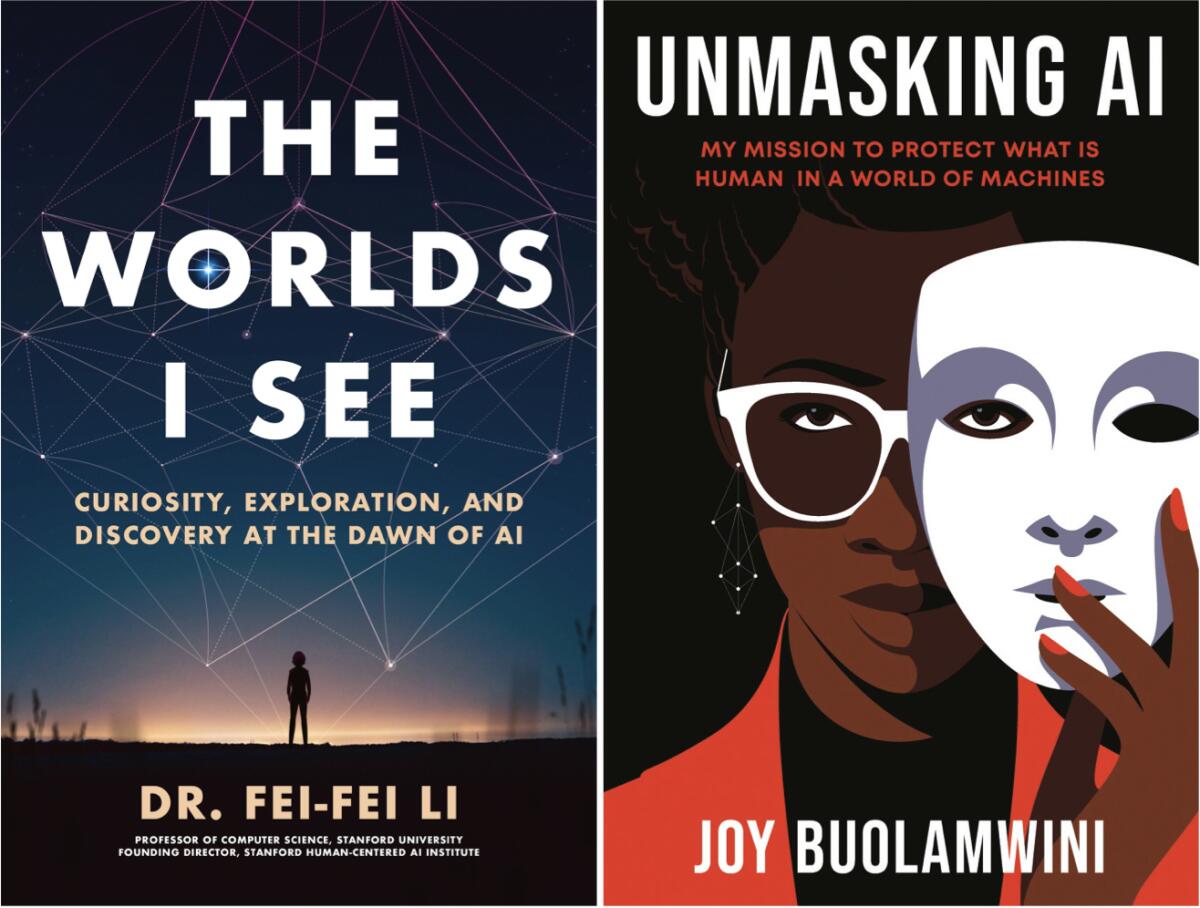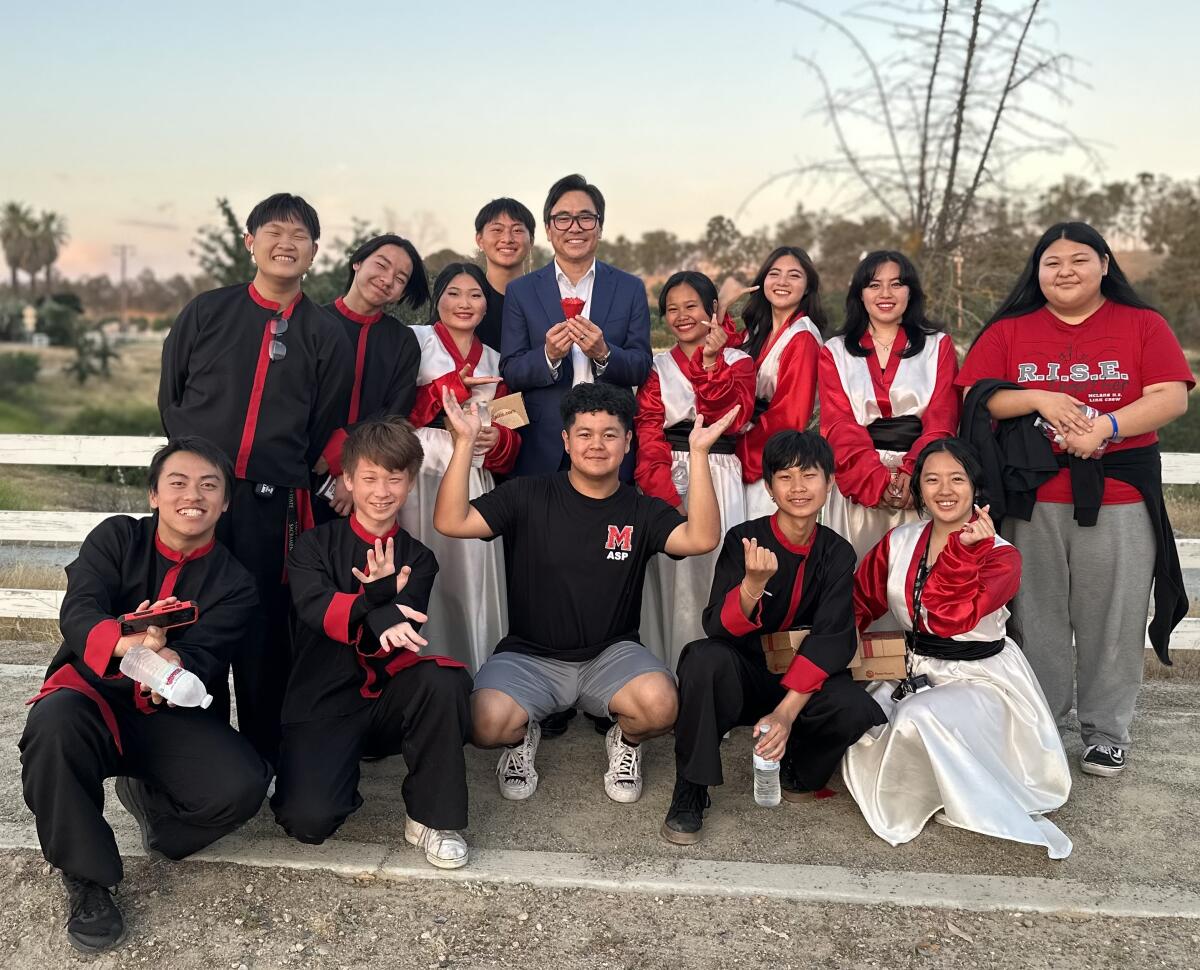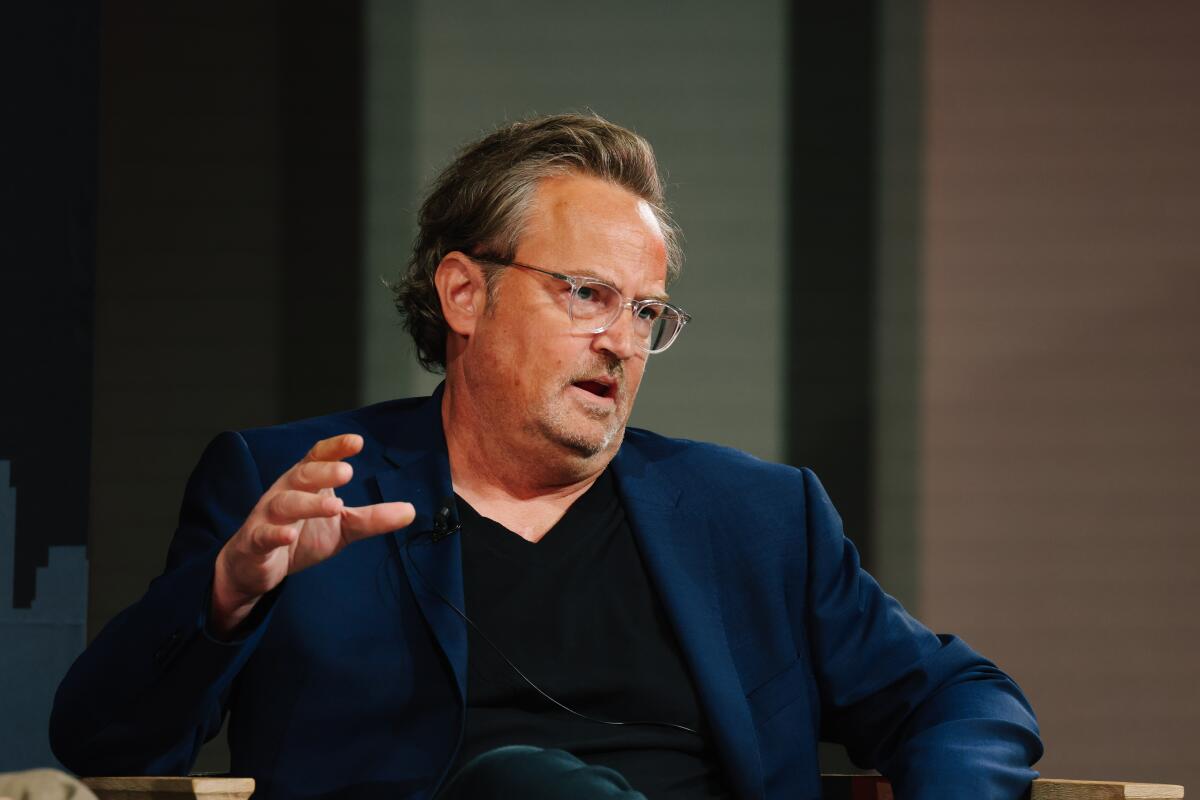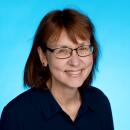Book club: How an author exposed the bias of the tech that runs our lives

Joy Buolamwini and Fei-Fei Li join L.A. Times Book Club readers Nov. 14 to discuss the perils and possibilities of AI
Good morning, and welcome to the L.A. Times Book Club newsletter.
In a riveting interview with artificial intelligence expert Joy Buolamwini, tech columnist Brian Merchant reveals why she felt compelled to become one of the nation’s preeminent AI scholars and critics — and why everyone should care about her work and her new book, “Unmasking AI.”
Merchant describes Buolamwini’s book as a “compelling, digestible guide” to some of the pressing and profound issues raised by the rapid growth of artificial intelligence.
As a college student, Buolamwini just wanted to build cool robots. Instead she ended up exposing big tech and what she calls “the coded gaze.” This is the bias and racism she uncovered deep inside the essential systems that increasingly determine the rules for how we live and work. As part of her research, she co-authored a landmark paper that revealed how facial recognition systems deployed by Microsoft, Amazon and Facebook failed to correctly identify women, and especially women of color, far more frequently than they did white men.
Buolamwini founded the Algorithmic Justice League to expose and counter the effects of the coded gaze. “When you have AI systems that determine if you get hired or fired, if you get admitted into college, or informs the decisions if you have access to medical treatment,” she says, “those types of systems are much harder to see.”
On Nov. 14 Buolamwini will join the L.A. Times Book Club for a livestreamed conversation, also featuring Fei-Fei Li, author of “The Worlds I See,” about the growth of AI and its impact on our humanity.
Like Buolamwini, Li is a prominent voice working to build a more inclusive, problem-solving AI future. Li is co-director of the Stanford Human-Centered AI Institute and also co-founded AI4ALL, a nonprofit dedicated to expanding opportunities to study computing for underrepresented youth, including girls and people of color.
Li and Buolamwini will talk with Times audio head Jazmín Aguilera and Merchant, author of “Blood in the Machine,” in a livestreaming virtual event starting at 6 p.m. Pacific. Sign up for direct links and signed books.
Tell us: What would you like to ask our guest authors? Share your questions and comments in Eventbrite or send an email to bookclub@latimes.com.
What’s next
California Poet Laureate Lee Herrick, a Fresno writer and professor who celebrates his home in the poem “My California,” has spent the last year on the road meeting with readers, students, festival-goers and community groups up and down the state
On Dec. 12 Herrick joins the L.A. Times Book Club for a virtual conversation with Times editor Steve Padilla about his first year as California’s poet in chief. (Sign-up information is coming soon.)

This fall Herrick is launching “Our California,” a project in partnership with the California Arts Council that invites Californians to write poems about their hometowns, “exploring what they love about it, what joy they find in it, what they would change about it, or what they hope for.”
Gov. Gavin Newsom named Herrick the state’s 10th poet laureate in November 2022. Formerly Fresno’s poet laureate, Herrick teaches at Fresno City College and in the MFA program at the University of Nevada, Reno at Lake Tahoe. He’s the author of three poetry collections, most recently “Scar and Flower.”
Herrick spoke about the importance of libraries during a recent visit to Pacific Grove. “When the world goes down, I think that three types of people will survive,” he said: “Farmers, poets and librarians.”
Setting the scene
On the Los Angeles Public Library’s blog, librarian Kelly Wallace digs into the in-house California Index and shares photo collections and other resources for novelists trying to re-create authentic L.A. scenes and for any reader curious about the city’s fashion, neighborhoods, restaurants, climate, social norms and politics of decades past.
She also shares the experiences of YA author and senior librarian Mary McCoy. “Searching the California Index,” McCoy says, “is like shopping at the world’s best thrift store.”
I followed up with McCoy for more pointers. “I really did use the LAPL Photo Collection to find out how much smog there would have been in downtown in 1947, and the Street Address Directories to figure out what neighborhood a film studio publicist might have lived in,” she tells me.
How do you use the California Index to research your books? I use it like I’m a private detective in a public records database. I’ll throw names, neighborhoods, landmarks in there and see what comes up. One thing to bear in mind is that this resource is truly an old-school index. So while some documents have been scanned, most of what you’ll find are citations that will require an in-person visit to the library. But it’s through the California Index that I discovered the work of Carey McWilliams and W.W. Robinson. Their names just kept coming up, so I started seeking them out.
What’s the most surprising information you’ve discovered? If you ever want to lose a day, just type “cults” or “sects” into the California Index. I turned up everything from an article about failed utopian communes in the San Fernando Valley between 1910 and 1930 to references for the criminal proceedings against a 1980s West L.A. sex cult called Church of the Most High Goddess, and that doesn’t even scratch the surface.
What are you working on? I’ve been working on a detective story set in the ’80s L.A. goth and metal scenes, and have really appreciated how much access to digitized newspaper collections has exploded. When I was researching my first novel a decade ago, there wasn’t nearly as much.
What resources do you most often suggest for writers? Library cards — as many as they’ll let you have! And even if you can’t visit in person, don’t be afraid to contact a librarian, especially if you have a very specific question.
What’s the last book that kept you up at night? “The Downtown Pop Underground” by Kembrew McLeod, which really digs into the queer, drag and off-off-Broadway roots of the punk scene, and “Ducks: Two Years in the Oil Sands” by Kate Beaton, which was not what I expected but completely riveting.
Keep reading
Lasting legacy: Actor Matthew Perry may be best known for playing Chandler Bing on “Friends,” but for those who struggled with addiction, the actor’s memoir, “Friends, Lovers, and the Big Terrible Thing” might be his most impactful work.
When asked at April’s Festival of Books how he’d like to be remembered, Perry said: “As a guy who lived life, loved well, lived well and helped people. That running into me was a good thing, and not something bad.” (Audience editor David Viramontes rounds up The Times’ complete coverage of Perry here.)

$7-million dream: Legendary California author John Steinbeck’s vintage sardine boat makes its modern debut. “Darwin had the Beagle, Hemingway the Pilar, and for writer John Steinbeck and biologist Ed Ricketts, there was the Western Flyer, hallowed ground for their six-week journey in the spring of 1940 to the Sea of Cortez, writes Thomas Curwen from Moss Landing.
New releases: Check out 10 books to add to your reading list in November.
Voice casting: Readers are buzzing about Michelle Williams’ narration of Britney Spears’ bestselling new memoir, “The Woman in Me.” In the New York Times, Frank Rojas looks at what goes into matching a celebrity reader such as Meryl Streep or Reese Witherspoon with an audiobook. “They aren’t reading, they are performing,” said Lisa Hintelmann, the head of casting and talent at Audible. “They want to be able to give an actual performance that is coming exclusively from their voice.”
Spiritual awakening via giant cactus: For Los Angeles writer Melissa Broder, the Southern California desert provides a perfect backdrop for her new novel, a “witty, psychedelic exploration” about a woman navigating complex feelings of “anticipatory grief,” writes Shaad D’Souza in the Guardian. “‘Death Valley’ is never, ever boring,” says reviewer Jessica Ferri in The Times. “This is high praise considering that our heroine spends 85% of the book in the desert and the rest at a Best Western.”
Gifts for readers and more: The L.A. Times 2023 Holiday Gift Guide landed and includes 18 of the year’s best memoirs, biographies and cultural histories. You’ll also find only-in-L.A. shopping tips, presents for cooks and food lovers and ideas for people who cherish experiences over things, such as Esotouric’s Raymond Chander bus tour, which includes a visit to the the downtown office building where Chandler worked for the Dabney Oil Co. until his 1932 firing prompted the launch of his literary career.
Finally, as Giving Tuesday approaches, please consider a tax-deductible contribution to the Los Angeles Times Community Fund. If you enjoy our live events with authors and newsmakers, sign on as an L.A. Times Book Club benefactor. You’ll help us produce more live events in 2024, both in-person and virtual, and we’ll feature your name and organization online and at the next Book Club night. Thank you for all the support and amazing participation all year long in our community book club.
Sign up for our Book Club newsletter
Get the latest news, events and more from the Los Angeles Times Book Club, and help us get L.A. reading and talking.
You may occasionally receive promotional content from the Los Angeles Times.




